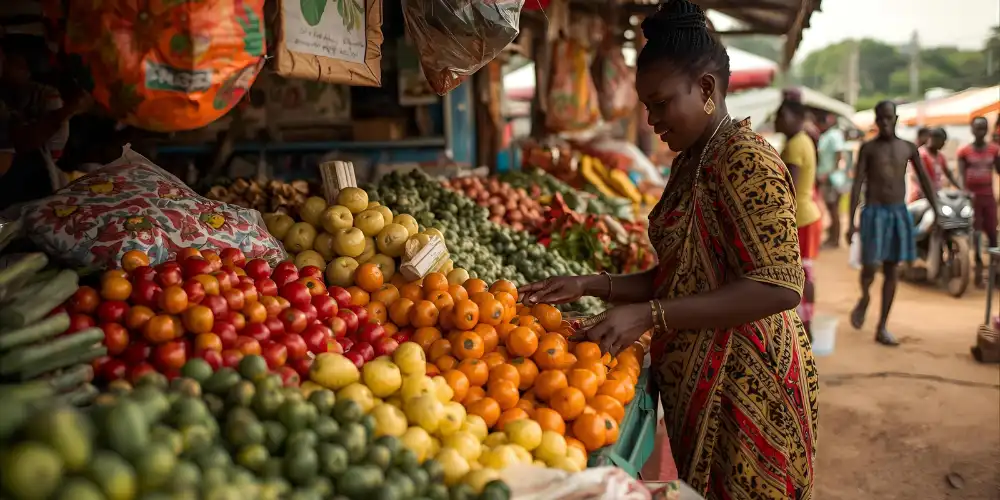Introduction
Access to food markets is a crucial component of food security across Africa. While the continent has immense agricultural potential, rural communities frequently face obstacles that hinder their ability to obtain essential food resources. These disparities are influenced by multiple factors, including infrastructure deficits, economic challenges, and geographic isolation. Understanding the scope of these challenges and the underlying causes is essential to developing solutions that ensure equitable access to food markets for all Africans.
This article examines the current state of access to food markets in Africa, explores the impacts on food security, and identifies strategies that can help bridge the gaps. Using data from reputable sources such as the World Food Programme and OpenStreetMap, we analyze patterns, regional variations, and potential policy interventions.
Data Analysis: Unequal Access to Food Markets
Recent studies leveraging geospatial data have uncovered striking disparities in market accessibility across Africa. In many rural areas, residents must travel more than 30 minutes to reach the nearest food market, a situation that severely limits their purchasing options and reduces food security. For example, in sub-Saharan Africa, nearly 40% of rural households are located more than 30 minutes from a functioning market.
Data also highlights the uneven distribution of markets, with urban centers hosting a majority of facilities while rural and remote areas remain underserved. The lack of accessible roads, bridges, and transportation options exacerbates these inequities. By analyzing patterns of population density, market location, and transport networks, researchers can identify priority areas for intervention.
Impact on Food Security
Restricted access to food markets has direct consequences on nutrition and food security. Communities far from markets often face limited food variety and higher prices due to transport costs. The World Food Programme reports that malnutrition rates are significantly higher in regions with limited market access, particularly among children under five.
Moreover, during periods of drought or economic downturns, households in remote regions are disproportionately affected. Lack of nearby markets reduces the ability to obtain emergency food supplies, leaving populations vulnerable. Ensuring equitable access to food markets is therefore a critical component of broader food security strategies.
Challenges in Improving Market Access
Several interconnected factors contribute to unequal access to food markets. Infrastructure deficits, such as poorly maintained roads, lack of bridges, and unreliable transport, are significant barriers. Political instability and local conflicts can further restrict mobility, making market access unsafe or impossible in some regions.
Economic barriers also play a role. Low-income households may be unable to afford transport costs or pay higher prices in distant markets. Additionally, market inefficiencies, such as irregular supply chains or limited storage facilities, reduce the availability of fresh and nutritious food, perpetuating disparities.
Proposed Solutions for Better Access
Addressing disparities in access to food markets requires multi-faceted interventions. Investment in infrastructure, including road construction and maintenance, is fundamental. Building more local markets in underserved areas can directly reduce travel times and improve food availability.
Economic support for small-scale farmers, such as microloans, subsidies, and training programs, enhances their ability to supply markets consistently. Technology-driven solutions, including mobile platforms for market information and digital payment systems, can reduce transaction costs and facilitate better market integration.
Case Studies: Success Stories in Africa
Several initiatives across Africa demonstrate how targeted interventions can improve market access. In Kenya, community-driven market projects have built local marketplaces and improved transport connectivity. This initiative has increased food availability and reduced prices for local communities.
In Ghana, mobile technology platforms connect farmers directly to markets, allowing them to sell produce without relying on intermediaries. These efforts have enhanced efficiency and increased income for rural producers, illustrating the potential of combining infrastructure and technology solutions.
Role of Technology in Enhancing Food Market Access
Digital tools are increasingly vital for bridging gaps in market accessibility. Mobile applications provide real-time information about market locations, product availability, and pricing. Farmers can use these platforms to identify demand patterns and optimize supply chains.
Additionally, digital financial services reduce reliance on cash and provide more secure and convenient transaction methods. By integrating technology into the food distribution system, access to food markets can be significantly improved, particularly for remote communities.
Policy Implications
Government policies are critical in ensuring equitable access to food markets. Policies that prioritize rural infrastructure development, support smallholder farmers, and incentivize private investment in markets create an enabling environment for improved food access. Regional cooperation among African nations can further facilitate cross-border trade and reduce disparities.
Evidence-based policymaking, informed by geospatial and socioeconomic data, helps identify areas with the greatest need. Policymakers can then allocate resources strategically to maximize impact on food security outcomes.
International Cooperation and Support
Global organizations and development partners play a complementary role. Agencies such as the OECD provide technical support, funding, and knowledge-sharing platforms that enable countries to implement effective interventions. Coordinated international support ensures that best practices and lessons learned are disseminated across the continent.
International partnerships can also help mobilize resources for infrastructure, market development, and capacity-building programs, ensuring that local communities benefit from sustainable and resilient food systems.
Conclusion
Unequal access to food markets continues to pose a major challenge to food security in Africa. By addressing infrastructure gaps, supporting small-scale farmers, integrating technology, and leveraging policy and international cooperation, significant progress can be made toward equitable access. The ultimate goal is a continent where all communities, regardless of location, have reliable access to nutritious food and thriving markets.
Ensuring improved food market access is not only vital for current populations but also critical for the future of sustainable development in Africa.
For more news, click here.
For additional insights, visit OECD – Food Systems, Food Security, and Nutrition.




